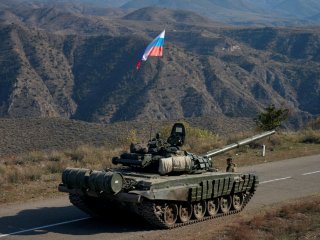Lawrence J. Haas

Even at this extremely polarized time in Washington, a bipartisan consensus continues to grow that China now represents the biggest threat to the United States.
President Joe Biden is implementing a “pivot to Asia” that President Barack Obama first enunciated, inking a new U.S. alliance with Britain and Australia that will help the latter deploy nuclear-powered submarines in the Pacific. Meanwhile, as Biden and China’s Xi Jinping prepared to chat this week, the House Armed Services Committee’s top Republican, Mike Rogers, called China’s Communist Party “the greatest threat to our nation today.”
Currently, however, some of the world’s most dangerous flashpoints emanate not from China but from Russia. They remind us that—while we must address China’s multifaceted efforts to supplant America as the world’s leading power—we also need to retain our focus on Russia’s machinations under the leadership of its strongman president, Vladimir Putin.
Putin has sent nearly one hundred thousand Russian troops to its border with Ukraine, according to Ukrainian President Volodymyr Zelensky, setting off alarm bells in Washington and Europe that he’s planning to invade.
The alarm bells are particularly loud for at least two reasons. First, Russia has attacked Ukraine before, most prominently in 2014 when it annexed the Crimean Peninsula, triggering sanctions against Russia by the United States, European Union (EU), other countries, and international organizations.
Second, Russia’s present troop surge dwarfs its surge to the border of last spring, which also alarmed Washington and Europe. Putin later sent some of those troops back to their bases, easing concerns at that time, but Washington is now worried that—in the words of Congressman Mike Turner, a Republican on the House Armed Services and Intelligence committees—“Russia has different intentions this time.”
At the same time, Putin is supporting (if not privately directing) the brazen efforts of Belarusian dictator Alexander Lukashenko to orchestrate a humanitarian crisis along his country’s common border with Poland—in hopes of pressuring the EU to end its sanctions against him over his fraudulent re-election last year.
In recent weeks, Lukashenko has encouraged families from the Middle East and the surrounding region to migrate to Belarus, easing visa restrictions and increasing the number of flights from the region by his state-operated airline. Rather than receive the humanitarian aid they were expecting, however, three thousand to four thousand such migrants have become pawns in Lukashenko’s conflict with the EU.
Belarussian authorities have pushed the migrants to the nation’s border with Poland (and, to some extent, to those with Latvia and Lithuania as well), advised them on how to cross the Polish border, and given them wire cutters and axes to do so. But Polish forces are defending the boundary and not letting the migrants through. As a result, these migrants are trapped along the border, where they’re beginning to freeze to death.
Rather than withdraw its earlier sanctions, as Lukashenko has sought, the EU announced that it will impose new sanctions on airlines, travel agencies, and individuals with ties to what its top diplomat, Josep Borrell, called “this illegal push of migrants.”
Russia’s maneuvers don’t stop there, however. While threatening its neighbors and supporting like-minded friends, Russia also has significantly upgraded its military strength, which has reached its highest level since the Cold War, the International Institute for Strategic Studies, a leading British think tank, reported.
After Russia “struggled to defeat” the much smaller Republic of Georgia in a five-day war in 2008, the institute wrote, Russian leaders launched a largescale military modernization effort in 2010 that has “ultimately provided Moscow with a credible tool for pursuing its national policy goals.”
On the military front, Russia raised further concerns in Washington in recent days by conducting a test missile strike against an old Soviet satellite in space. According to U.S. officials, not only did the strike create hundreds of thousands of pieces of debris that could damage other satellites and threaten astronauts aboard the International Space Station, but it also put the lie to Moscow’s claim that it does not plan to weaponize space.
Complicating matters further, Moscow is strengthening its military and strategic ties to Beijing in a growing relationship that seeks to counter U.S. power. Late last month, for instance, China and Russia conducted a joint naval exercise, with five warships from each nation that sailed near Japan.
Looking to the future, the RAND Corporation wrote in a major report this year, we should expect “greater Sino-Soviet cooperation,” with “further diffusion of Chinese and Russian military equipment, additional joint planning and exercises, potential joint basing, and eventually the possibility of joint military operations.”
Xi’s China may well be America’s biggest global threat. Nevertheless, U.S. policymakers must remain prepared to confront a hostile leader in Moscow who, too, is committed to challenging America and the West whenever and however he can.
No comments:
Post a Comment